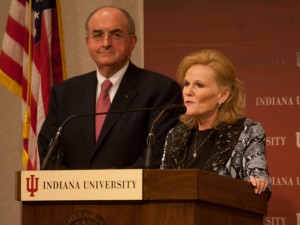How IU's Summer Tuition Cuts Could Quiet Statehouse Criticism

Courtesy Indiana University.
IU president Michael McRobbie looks on as Higher Education Commissioner Teresa Lubbers speaks during a press conference on Monday, October 24 in Indianapolis. McRobbie was announcing a 25 percent summer semester tuition discount for in-state undergraduate students. (Photo via...)
As they took the stage together for a press conference Monday, Indiana University president Michael McRobbie and Higher Education Commissioner Teresa Lubbers weren’t just announcing a plan to cut summer school tuition.
They were declaring a political ceasefire.
No, this isn’t a Camp David accord. But IU has had a target on its back in the course of a sometimes-heated political battle over the rising cost of attending the state’s universities — partially because the school has raised tuition and fees more than Lubbers or top Republican lawmakers would like.
But with Lubbers and Gov. Mitch Daniels praising the tuition cuts, the move for IU could be just as much about curbing students’ expenses as it is about turning down the temperature of a heated political debate.
- The Politics of TuitionOn Monday, Indiana University announced cuts to summer school tuition by 25 percent for all in-state undergraduates statewide. That follows a move by Indiana State University to roll back a planned tuition hike. StateImpact Indiana‘s Kyle Stokes looks at the financial and political calculations behind the move.Download
Reaching Détente?
The summer tuition cuts, which IU projects will cost the university (and save its students) a total of $11 million this summer statewide, could help stave off legislatively-imposed restrictions on tuition increases.
State lawmakers on both sides of the aisle tell StateImpact it’s possible the state legislature could impose strict limits — perhaps in the next state budget in 2013 — on the amount IU and other state universities can raise their tuition each year. Such a tuition cap would be tied to the annual recommendations of the Commission for Higher Education, which Lubbers heads.
Rep. Peggy Welch, D-Bloomington, says she believes slashing summer tuition represents a sincere desire by the university to lower students’ cost of attendance.
“But,” Welch adds, “I’m sure there’s also the thought, ‘We need to please [Republican] leadership in the Indiana General Assembly, because if we don’t, they’re going to impose those absolute caps, and we want to avoid that if possible.'”
Sen. Luke Kenley, R-Noblesville, said he believes there’s enough legislative will to implement the limits. Kenley says he doesn’t approve of the move, but feels as though universities and the legislature need to work better together to slow the rate of tuition increases:
I’m trying to find a way to make that not happen by having the universities reach an agreement with [General Assembly leadership] on an overall basis regarding the next couple of years… We are jeopardizing that balance that we have today, because we [the universities, legislature and Commission] are not working quite as a team as we have in the past. And I think the issues of affordability and accessibility for in-state students remains a concern for people in the General Assembly.
Putting The Past Behind
Monday’s press conference appeared to be an attempt by the Commission and IU to put the past behind them. That the Commissioner for Higher Education and Indiana University’s president were able to share the stage was remarkable, given recent history between the two organizations:
—State Sen. Luke Kenley, R-Noblesville
In May, the Commission for Higher Education accused IU officials of skirting limits on tuition increases the Commission had recommended for this year.
The Commission wanted IU and Purdue to limit tuition increases to 3.5 percent. When IU increased tuition and added mandatory student fees, raising overall cost of attendance by 5.5 percent, the commission balked.
Lubbers even hinted the General Assembly might withhold state funding for IU, as lawmakers threatened to do in 2009.
But Lubbers praised the summer tuition cuts on Monday, calling the plan a step in the right direction.
“It begins with the acknowledgement that affordability is a key issue for many Hoosier students and finds a way to drive more cost savings to Hoosier students. It acknowledges that for many of them, they want and need the option to graduate in a more timely period,” Lubbers said.
A ‘Perception’ Gap Remains?
But few see a move to cut summer tuition as a fix to what the university sees as the underlying problem: decreasing state funding.
IU says its state funding has “decreased by 30 percent in constant dollars over the last two decades.” Despite pressure from policymakers in Indianapolis, IU officials say they feel they have no way to handle that other than to increase tuition.
Kenley disputes that state appropriations are substantively decreasing. He says how one understands the state funding question is a matter of “perspective”:
We haven’t increased our funding as fast as the universities have raised tuition. If they’re always going to raise tuition at two or three times the rate of inflation, and we [the state] are just funding at the rate of inflation, we’ll always be what appears to be a smaller piece of the pie. But that’s because we’ve allowed them the freedom to make that decision, and they’re placing that relationship in jeopardy when they make those arguments and assert that somehow the state’s not doing its fair share.
Senate minority leader Vi Simpson, D-Ellettsville, disagrees with Kenley.
“The thing that’s irritating me these days is the disingenuous tone of ‘We’re giving you lots of money,’ and we don’t expect you to raise tuition, when in fact IU Bloomington was actually cut,” Simpson says.
Podcast: Play in new window | Download
